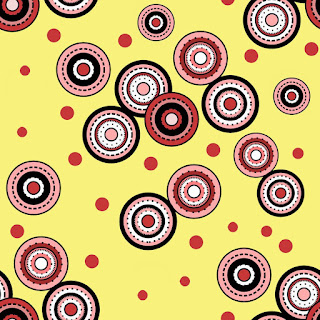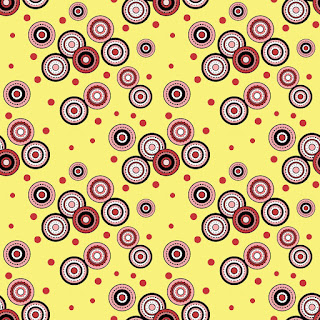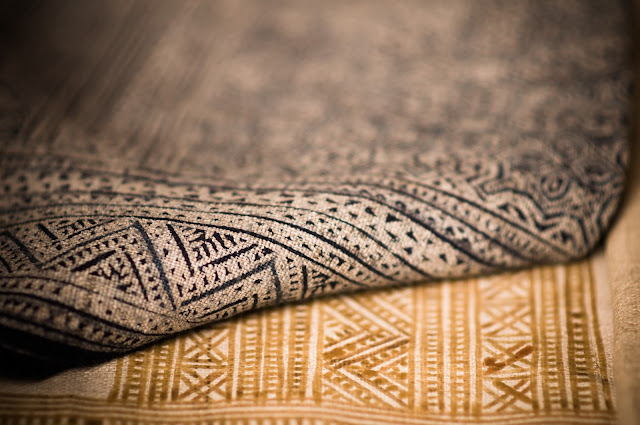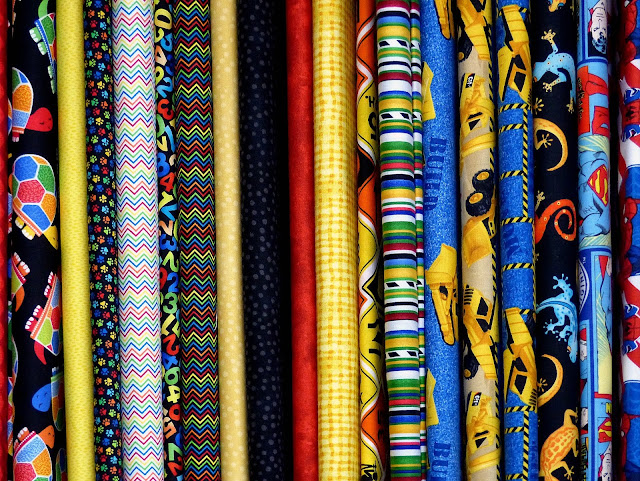This tutorial, such as it is, could easily be called How to create seamless tile repeats with Gimp. If you do a google search for Gimp seamless, you will find lots of tutorials. Because of that, I won't do a detailed tutorial. This is a follow-up of my review of A Field Guide to Fabric Design.
The main difficulty I had with Gimp and creating a seamless repeat is a problem filter*.
Don't use this filter:
Filters - Map - Make Seamless
The resulting image doesn't make an attractive repeat. It overlaps the repeat with transparencies.
Instead the offset tool, which is similar to Photoshop, is located:
Layers - Transform - Offset
Finding this tool made all the difference. Conversely, I played around with the select tool and moving layers around to accomplish the same thing. The offset tool works best with the design repeat located far from the image borders and in the center of your image. For more complex repeats, manually selecting parts of the image, copy-paste into a new image and moving them in layers works better.**
I started my experiment with a vector line drawing made in Inkscape and exported as a PNG file.
Next I pulled the line drawing into Gimp, added a background color, and then applied the offset tool. After that, I filled in the blank areas. Again, detailed instructions in the book for a simple repeat and more complex repeats.
Gimp has a handy tool that allows you to test your repeat located here.
Filters - Map - Small tiles
This is how my repeat looks now.
The repeat could use a bit more work, but I think you get the idea. A Field Guide to Fabric Design has information on how to improve your repeat and also how to create a whole collection around this one design.
Of course, the real challenge is matching up the colors with Pantone.
* I tried to take screenshots of all of this but my print screen button wasn't cooperating.
** One of these days I may create a tutorial for this, but it is a bit more involved. My trial video demo took about 20 minutes.
Showing posts with label Fabric Prints. Show all posts
Showing posts with label Fabric Prints. Show all posts
January 02, 2013
December 27, 2012
Review : A field guide to fabric design

I hope all had a wonderful Christmas. It is during this time, the week between Christmas and New Year's, that I spend time cleaning off my desk and sorting my papers in preparation for the tax man. As depressing as it is to know that we will probably owe taxes this April, it is strangely cathartic to clear off the desk and start fresh for next year. Among the piles of papers is the book A field guide to fabric design by Kimberly Kight of the True Up blog.
Fabric design, or textile surface design, has long fascinated me. The ability to play with the color, proportion, and spacing of a design through a repeat is very intriguing. Kight briefly explores different styles, design and color fundamentals as applied to textiles. This includes a look at both digital and traditional design techniques. The meat of the book is the explanation of how repeats are created, including different repeat styles. Both digital and traditional (hand drawn) techniques are explained. Interspersed throughout the book are comments from fabric designers, both established and just starting out, from which the reader can draw inspiration. Finally, Kight presents ideas of how to print and sell your own fabric. What quickly becomes clear is that textiles fabric designing is a competitive and difficult market.
There are several instructional overviews including hand block printing, screen printing, designing a collection, and textile basics. All are comprehensive and a good foundation for further study and exploration.
The book is laid out well and is easy to read and follow. The instructions for designing repeats are clear and easy to understand. Kight strongly encourages the use of Adobe Illustrator and Photoshop because of their common usage in design work. She discourages the use of open source programs such as Gimp and Inkscape, which is unfortunate. Her primary objections to Gimp and Inkscape are the lack of Pantone color palettes*. The objection is valid because Pantone is used to ensure proper color matching. But anyone that has printed fabric knows that colors don't always work out as expected even when using Pantone**. Pantone color palettes are proprietary and that is the reason Gimp and Inkscape do not include them by default. In other words, their exclusion is entirely a legal and financial matter and not anything lacking in the software itself. But the palettes can be acquired (not easily) and added. Also, Pantone has CMYK and RGB equivalents (here is one tutorial) and if you are serious, you can buy a set of color chips and match things up. There will probably be a lot of back and forth until the correct colors are obtained, and that is probably why most designers use Illustrator and Photoshop (because there will be less of that). At the end of the day though, Gimp and Inkscape are just as robust as their commercial counterparts. In a separate blog article, I'll show how easy it is to design repeats using Gimp.
I liked this book a lot and I will reference it when I play around with designs, whether for a desktop wallpaper or for fabric I intend on printing.
*For more information google Gimp and Pantone.
**I managed to design a book cover using only free software and have it printed exactly as expected at one printer and not at another. There are a lot of variables between designing on a screen and a printer's capabilities that can't be completely solved by the use of one color matching system.
November 16, 2012
Question on fabric copyrights.
I've received some questions and thought I would take some time to answer them in a series of short blog entries.
Lara asked a question on fabric copyrights.
I wonder if you can help!? I came across your blog and a similar thing happened to me - I make bags and was sold fabric for the bags that infringe on a large company's design rights. I have now found some different fabric and am wondering how I can double check that it is not copyrighted to anyone - do you know how I can check this?In the US, fabric that is sold is subject to the First Sale Doctrine, meaning you can use it as you choose. The exception to this is if the image contains licensed images or trademarks. An example of this would be a team logo or recognized cartoon character. Though even the use of fabric with licensed images is up for debate.* This right is currently being challenged as we speak at the US Supreme Court, which if the judges rule a certain way threatens this right. It would probably upend business as we know it.
Anyway, the current trend among textile surface designers is to license their designs to fabric converters (such as Michael Miller, as an example) while retaining all their copyrights. They seem to be ok with personal, home use of the fabric printed with their designs, but they don't like their designs being used on commercially made products without their permission. The idea is certainly in conflict with the First Sale Doctrine.
There have been instances of copyright and trademark infringement on fabric in the US. In those cases, the design on the fabric was copied and printed outside the distribution and control of the original designer and/or fabric manufacturer.
I think the situation presented in this question is a bit complex and I don't know enough of the details to offer much help. I think Lara may be from the UK? In which case there are different issues at play. The UK and European Union have seized on the idea of design rights and patents. In that case, a fabric print in combination with a specific product can be protected. I don't know how you can check on the copyright status or design rights of a particular print. You would probably have to rely on the integrity of the fabric supplier. In any event I think it would be difficult to ever know for sure if something was ok to use.
In the US, the answer is similar. Fabric prints have traditionally not been registered with the US copyright office. Designs, as in completed items like a dress, are not protected. So, you must rely on the integrity of the fabric supplier to supply fabric that is available for the use you intend. Intellectual property lawyers may be able to help, but I don't how many are versed on the complexities of the textile and fashion industries. Unfortunately, if the above trends continue (and if certain legislation is passed) the need for an IP lawyer will become a requirement for designers.
*If you can look past the hyperbole of the Tabberone site, they do make some interesting points.
April 03, 2012
More on copyrights - this time on fabric
I've wanted to write a blog entry on the latest state of copyright and intellectual property issues in the fashion and sewn products business for a while. I've been watching the assertions of copyright restrictions by indie pattern designers (sewing and knitting) and the appearance of copyright restriction on fabric selvages. I've struggled with how to approach the topic because it can become quite heated very quickly.
As a fashion designer, I like to use printed cotton fabrics in my girls dresses. Over the last several years, I've been watching the rise and popularity of certain fabric print lines and their designers. I've loved the prints they are producing because they have hit upon a formula which is constantly fresh and inspiring. Long gone are the sweet floral rose buds that were so typical for infant clothing. Now there is an explosion of modern, colorful designs that are mixed and matched like crazy.
In the fashion industry there is an assumption that fabric available for sale can be used to make commercially sold products*. We don't usually take the time to ask for permission from every vendor and copyright holder before we design a season. To do so would bog down the process considerably. And let's not forget the concept of the first sale doctrine, which in the United States says the creator of an object loses control of it once the item has been sold**. Even so, I went so far as to ask permission on one fabric design a few years ago because it was designed by a well known scrapbook paper designer. This designer was known to go after individuals who used her scrapbook products to make new products to sell. But when I asked the fabric vendor, they thought I was crazy - of course I could use the fabric for a commercial product.
Well it appears with the rise of celebrity fabric designers***, that is changing. I've been reading of the recent case involving Kate Spain and C&T Publishing/Emily Cier. I won't rehash the whole thing but you can read a good analysis at The Free Motion Quilting Project. With the resulting chaos and ill will that is now floating around the quilting industry, you can see how quickly creativity can be curtailed.
This one situation throws chaos into more than just quilts. There are many childrens clothing designers, accessory makers, and manufacturers who use fabrics from celebrity fabric designers. What's to be done there? I can assure you that the fashion industry as a whole will not stand for it. There is a cost associated with printing up fabric, but it is not as hard to come up with our own designs and print our own fabric as it has been in the past. Those fabric designers need to be careful that they don't alienate the very customers they seek to serve by limiting what can done with the fabric they create. They may loose the very income they seek to protect.
*Generally speaking, it is suggested that a fashion designer not use a fabric print that contains a licensed character such as Mickey Mouse. Doing so crosses into trademark territory and Disney will come after you. There are some designs which are so distinctive that there can be no doubt that the design refers to another brand. So while the first sale doctrine may apply, why would you want to go there? In addition, it is copyright infringement to copy an existing fabric design and print it yourself. Though that gets into murky water because there are many, many fabric designs which are technically in the public domain, though which is and is not public domain is difficult to determine.
**Those statements printed on fabric selvages that limit usage to personal use are probably not legally binding due to the first sale doctrine. Though I'm certain some individuals may actually try to enforce it with lawsuits and threats anyway. If you see it and you have a concern, then just don't buy it. And as mentioned above, some companies will actually come after you.
***Please don't think that the usage of the terms celebrity fabric designers is disparaging. On the contrary, these fabric designers deserve the recognition that comes with their talent. The term celebrity simply refers to their popularity and the expansion of their brand across multiple product lines. Just as there are celebrity chefs, actors, and what not, there can be celebrity fabric designers.
July 17, 2009
What is a fabric converter?
Fabric or textile converters may not be a term some are familiar with. Fabric or textile converters are factories that embroidery, dye, print, flock, bead, pleat, etc. fabric. They may specialize in one area and simply call themselves embroiderers or printers, or they may provide multiple types of conversions. A fabric converter takes specially prepared or greige (pronounced grey) fabric and converts it into finished goods.
There are various forms of greige goods. Generally greige goods are fabrics that come right off the loom. Some have been minimally processed, not processed at all, or the yarns have been processed prior to weaving or knitting. There are various types of finishes that depend on the desired outcome. There are finishes that prepare the fabric for printing or dying. Other finishes enhance the fabric's qualities, such as singeing, desizing, scouring, bleaching, calendaring, and many more. These are finishes done to the fabric prior to printing, dying, or embroidering and so they are still called greige goods by some. Since these finishes do finish the fabric to some degree, they are technically called by other names. There are various acronyms and labels for the different types of "greige" goods and it all becomes kind of fuzzy (or grey, heh) for me. In any event, greige goods are warehoused until an order comes in to print (or whatever) the fabric. Printing and embroidering are some of the fabric conversions done at the very last stage of fabric manufacturing.
July 15, 2009
Printing your own fabric pt. 2 : Sourcing Fabric Converters and Printers
Say you are a fashion designer or retailer and you want to custom print your own fabric. You have the skills (or the funds to hire a designer) to create artwork. There are many fashion designers, and even some retailers, who print their own fabric. Off the top of my head Laura Ashley, Ralph Lauren, and Ikea all print their own fabrics, though smaller companies also do it. This is a bit different than my previous blog entry (Printing your own fabric pt. 1), as these individuals are not necessarily textile designers professionally. But as part of a brand image or look, custom prints become necessary.
There is a lot of existing artwork already out there. Freelance textile and graphic designers are available to create the artwork to complement the look of a line. You can also hire graphic designers, though it may be helpful if they have experience in preparing artwork for textile printing. You could even create your own artwork if you have the skills and inclination. You should receive a "strike off" or proof to approve prior to printing. A strike off is a sample of the print and it should represent the actual fabrics, colors, and print registration of the final goods. Make sure to evaluate the strike off thoroughly before committing to a print run.
As a fashion designer, you can contact fabric converters/printers yourself. They can help walk you through the process of preparing the artwork, setting up the repeat and printing the goods. Each printer will vary in their abilities and processes, so don't be deterred if one place is not a good fit. There will likely be a set-up charge to prepare the artwork, so don't be surprised by this.
The biggest question when printing your fabric rests on minimums. How much fabric will you be willing to carry in inventory? Typical minimums average about 3,000 yards. The smaller the quantity, the higher the price per yard. Stateside factories generally require higher minimums. Overseas factories vary - some high, some lower. Some factories may break up the 3,000 yard minimum and allow you to do different colorways of the same print. Others may require 3,000 yards per colorway. Even then, some factories will do less yardage. It is all a matter of research and asking the right questions.
Q: "Can you do custom prints?"
A: "Yes, but it will be a 3,000 yard minimum and 6-8 weeks."
July 13, 2009
Printing your own fabric pt. 1
This may be a future series. I recently talked with someone who has been custom printing his own fabric for a few years now. There are several steps involved with printing your own fabric but it isn't as hard you might think. I am talking about having your designs professionally printed by a fabric converter. There are options that have become available to home hobbyists to print their own fabric, but it is extremely expensive. If you were to take this up as a business, you would need a printer who can print hundreds of yards at an affordable price or you would never make any money.
I have to say I admire some of the up and coming print designers. I admire their skill and ability to create a cohesive collection 1-2x/year. Many of these designers have training in the arts, either the fine arts or graphic design. On top of that, they have some experience working with cloth as seamstresses and pattern makers. I wish I was more skilled at designing prints. I think I could do it but I would need to dedicate a great deal more time to it. Maybe someday I will get up enough gumption to try it and print my own designs.
Traditionally, a textile designer creates their artwork using traditional media - paint and a brush, markers, pastels. At the very least then and now, an artist carries a sketchbook around with them everywhere. They are able to capture patterns and designs in the world around them and translate them into a fabric. They can pick colors suitable for apparel or interior fabrics.
I think most modern textile designers today create their artwork using computer aided design (CAD). Adobe Illustrator and Photoshop are the primary tools. (Free versions include Paint or Gimp, Inkscape). Artwork created in Illustrator or Photoshop is not immediately ready for printing. The artwork must be made into a repeat, created by a special filter or plug-in. The idea is to offset the image 50% horizontally and vertically and fill in with the offset parts. Look for a tiling filter or tool in your program to do it automatically. Once this step is taken, the artwork is ready to be printed by some methods (Spoonflower, for example).
For mass production, the artwork goes through some additional steps though I am sure the technology has changed since I was last exposed to it. There are specialized CAD packages in the industry that some artists use directly or through a trained technician. Artwork is brought into the software and the design is fine tuned through color reduction, recoloring, etc. The design is made into a repeat. The process is rather involved because digital artwork has to be translated into the chosen printing method. And there are several methods out there - heat transfer, roller printing, block, screen printing and digital. The method chosen depends on the converter's ability and/or appropriateness for the print.
If you want to be a textile designer, there are two main approaches. You can create artwork and shop it around to existing fabric manufacturers/printers/converters. Michael Miller, Westminster, and others buy the rights or license artwork from designers. Other designers print and sell their own fabrics. In either case you don't necessarily have to understand all the ins and outs of textile manufacturing and printing. Fabric converters/printers can take your artwork and prepare it for printing (their may be an up-charge or setup fee).
Anyway, more to come as I find this to be an interesting topic....
Subscribe to:
Comments (Atom)








